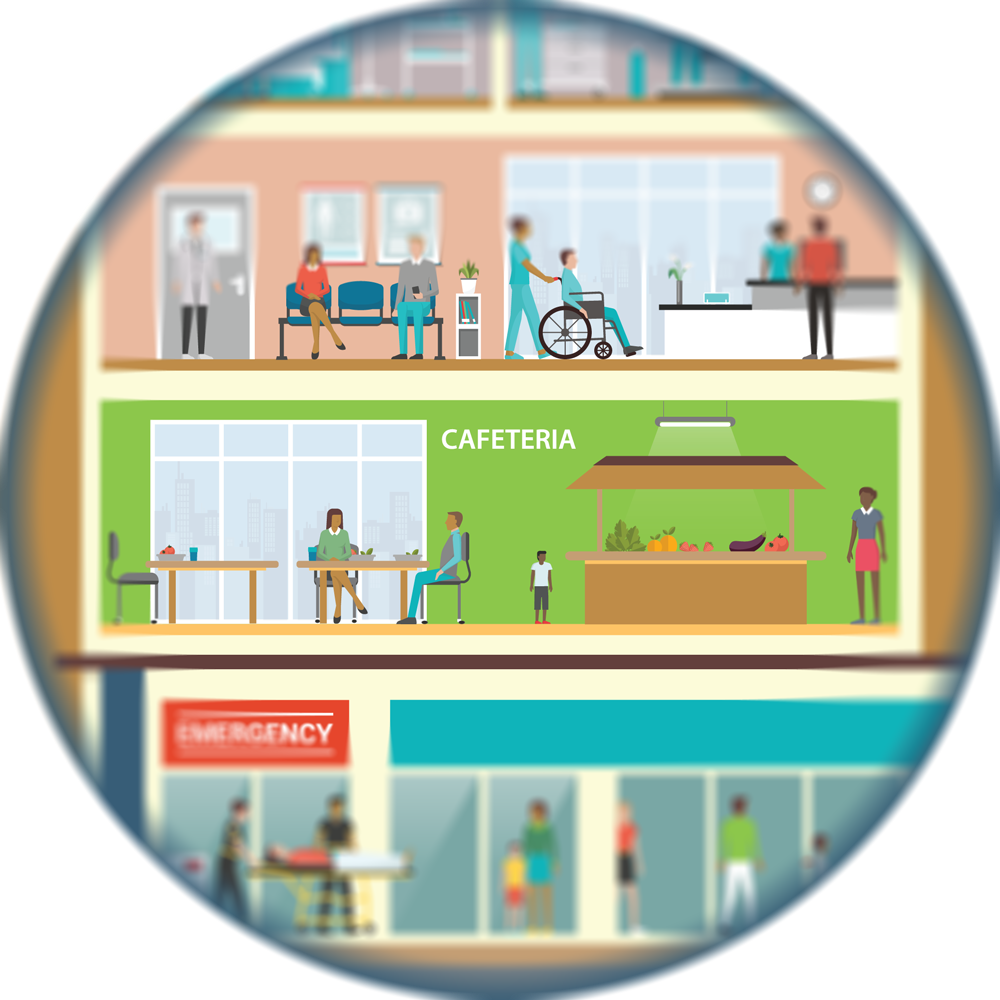Advocate Health Care – now part of Advocate Health – has committed to a 100% renewable electricity goal by 2030 across their Midwest system. This goal builds on extraordinary energy efficiency work throughout the health system including Atrium Health – also now part of Advocate Health – receiving the U.S. EPA’s Energy Star Partner of the Year Award for the sixth year in a row in 2023, Energy Star certification for 10 Midwest hospitals as of 2023, a renewables strategy evaluating both onsite projects and power purchase agreements, and eight locations throughout Illinois and Wisconsin hosting solar panels. With funding through the Illinois Solar for All program, one of these sites, Advocate South Suburban Hospital, has installed a 400 AC kW (541 DC kW) ground solar array to supply 5% of the facility’s electricity.
Climate Action:
A Playbook for Hospitals
Introduction
Climate change is a public health crisis – impacting our weather and environment, along with the quality of the air we breathe, the water we drink, and the food we eat. The most vulnerable members of our communities – children, people of color, the poor, people with disabilities or chronic diseases, and the elderly – are the ones who suffer the most.
Health care is on the front lines of climate change bearing the costs of increased illnesses, changes in disease prevalence, and the health impacts of more frequent extreme weather events. At the same time, health care operations contribute significantly to climate change and the very diseases it is trying to treat. The health care sector is responsible for 8.5% of U.S. greenhouse gas (GHG) emissions, with the U.S. health sector accounting for 25% of global health sector emissions.
Health care organizations have a distinct leadership opportunity to address climate change by following a three-pillar approach to climate-smart health care:
-
Mitigation: Reduce GHG emissions from operations and implement low-carbon health care delivery
-
Resilience: Prepare facilities for climate impacts and help build community health and climate resilience
-
Leadership: Use the trusted voice and purchasing power of the sector to support the transition to climate-smart policies and a low-carbon economy
This playbook captures how hospitals are operationalizing climate solutions – inspiring and encouraging hospitals to engage further in climate action while providing a path forward to achieving measurable progress and outcomes. The time has never been more critical for hospitals and health care to take action.
For more information on the Health Care Climate Council, visit our website.
 Lean and clean energy
Lean and clean energy

Due to their unique activities, more stringent code requirements, and 24/7 operations, hospitals are highly energy-intensive, using 2.5 times more energy per square foot than an office building. Health care organizations spend more than $6.5 billion on energy each year.
Consider the following:
-
Clean, renewable energy provides price predictability as well as competitive or cheaper prices than fossil fuels. Health care organizations can now use Inflation Reduction Act (IRA) incentives to reduce the financial barriers to procuring low-carbon energy alternatives. Distributed renewable energy plus storage can also help hospitals remain operational during extreme weather events or periods of peak demand.
- Over the last decade, wind energy prices have fallen 70% and solar photovoltaics have fallen 89% on average with the price of renewables falling below the cost of coal in 2018. The cost of renewables is predicted to considerably beat fossil fuels for decades to come.


Ascension’s environmental stewardship program met the Department of Energy’s Better Buildings Challenge goal of 20% energy reduction by 2020 across its acute care hospital portfolio. From 2008 through 2018, Ascension reduced energy usage by 29.2%, saved $61.9 million in cost avoidance, and reduced over 1.5 million tons of carbon dioxide emission across 141 health care facilities. Ascension also deployed a data dashboard to report facility operations (energy, water, temperature, humidity, and air changes) on a real-time basis.

From 2005 to 2015, Gundersen Health System became 56% more energy-efficient and installed every form of renewable energy – solar, wind, geothermal, biomass, landfill gas, anaerobic digestion – supporting community health and growing the local economy. Gundersen first achieved energy independence in October 2014. The health system saves $3 million annually from energy efficiency improvements. In 2019, Gundersen expanded its energy portfolio by installing a battery and microgrid at a new clinic.

New York’s Climate Leadership and Community Protection Act requires a state-wide reduction of greenhouse gas emissions by 40% by 2030 and at least 85% from 1990 levels by 2050. Northwell Health’s strategies to support these goals include hybrid energy solutions to maximize on-site efficiencies and maximizing load from the grid with distributed energy resources. By the end of 2021, Northwell reached 12.7% in electricity procurement from renewables, reduced its electricity usage by 4.5%, and achieved a 28.5% emissions reduction.

HealthPartners works collaboratively with electricity, heating, cooling, and natural gas utilities and uses utility data to increase energy efficiency, reduce emissions, and save money. HealthPartners’ participation in the Xcel Energy Commercial Efficiency program in 2021 and 2022 saved facilities over 2.4 million kWh of electricity and over 120,000 therms of natural gas. The system received over $215,000 in rebates from Xcel Energy and additional cost savings from decreased electricity and natural gas consumption.

Inova’s decarbonization plan serves as its roadmap for reducing energy use and Scopes 1 and 2 greenhouse gas emissions at the health system’s five legacy hospitals. The plan includes interim energy use intensity and carbon reduction goals with interventions including energy management and efficiency improvements, energy transition and electrification strategies, and renewable energy opportunities.

In 2017, Rochester Regional Health became the first health system to publicly announce a 100% renewable electricity goal by 2025. They have built a 500-kW solar array at their system headquarters, completed building a 5.5 MW solar farm, and have invested heavily in being an anchor for community solar systems, allowing the community members they serve to receive local renewable power and save money on their electric costs.

Seattle Children’s Hospital’s energy use intensity (EUI), as measured by the Washington State Clean Buildings Law, was 21% higher than the state-mandated target at the main hospital campus in 2021. An ASHRAE Level 2 audit was Seattle Children’s Hospital’s roadmap for reducing its EUI. After implementing a series of projects, its utility cost savings were approximately $600,000 in 2023, with an estimated $1 million in savings per year when the facility reaches compliance in 2024. The implemented projects have a payback of five years or less.
 Healthier food
Healthier food

As health care takes a more holistic approach to improving health, food is a critical element, both in terms of what a patient consumes as well as what a hospital serves or wastes. Hospitals and health systems across the country are achieving their organizational priorities by focusing on food-related initiatives. Consider the following:
-
Research from University of Michigan and Tulane University found that replacing 50% of animal products with plant-based foods in the U.S. would prevent more than 1.6 billion tons of GHG pollution by 2030.
-
Agriculture is responsible for 24% of global GHG emissions.
-
Project Drawdown, a research organization that reviews, analyses, and identifies the most viable global climate solutions lists food-related solutions 17 times in its list of 80 solutions – with plant-rich diets ranked at number four and regenerative agriculture at number 11.
- Project Drawdown estimates that if employed widely, regenerative agriculture could result in a total reduction of 23.2 gigatons of carbon dioxide and provide a $1.9 trillion financial return by 2050 on an investment of $57 billion.

Three stories above Boston Medical Center’s (BMC) power plant thrives a rooftop farm, helping them reach their 2030 vision of making Boston the healthiest urban population in the world. Along with harvesting close to 6,000 pounds per year, the farm is also used as an educational platform to create food resiliency in the city of Boston. The farm provides fresh, local produce to hospitalized patients and cafeterias, as well as the BMC teaching kitchen and therapeutic food pantry. The farm reduces the hospital's carbon footprint, increases sustainable space, and reduces energy use – including the energy required to transport food.

Hackensack Meridian Health partnered with dining services providers Sodexo, Morrison, and its in-house dining services to commit to the Cool Food Pledge. Championed by the World Resources Institute, the Cool Food Pledge focuses on offering diners delicious food that is better for the planet with the goal of slashing food-related GHG emissions by 25% by 2030. Hackensack Meridian brings their food budget of an impressive $22 million (over $4 million for meat procurement) in purchasing power to the table, as well as a commitment to reduce food-related supply chain emissions.

University of California Health’s commitment to the Cool Food Pledge led the system to develop tools to procure and serve more plant-based meals while increasing local and seasonal offerings. From 2017 to 2023, the system reduced its emissions from food purchasing by 25.43%, equivalent to taking 837 vehicles off the road, and increased the quality and type of meat purchased while reducing annual meat expenditure by about $60,000

University of Vermont Medical Center (UVMMC) procures over 59% of its food locally and sustainably – including food grown on their rooftop garden. Food waste is composted off-site, and then some of that compost is purchased back for use in the garden. UVMMC utilizes a room-service model for patients which helps to reduce food waste.
 Leadership
Leadership

Visionary health systems understand that addressing climate change must be core to their mission of improving health, and many are using their trusted voice to lead by example. Consider the following:
-
Health care professionals are among the most trusted messengers on climate change.
-
More and more, prospective employees are seeking job opportunities in organizations that reflect and align with their values regarding environmental stewardship. In a 2019 survey of millennials, 40% said they have chosen a job because the company performed better on sustainability and 70% shared they would choose to work at a company with a strong environmental agenda.

In 2022, CommonSpirit Health established a climate action plan that includes a governance structure, clear accountability for major work streams, incentive structures, and integration with other organizational processes like budgeting. Under its building and operations and supply chain pillars, CommonSpirit has committed to reaching net-zero emissions by 2040 across all three scopes, with an interim goal of cutting operational emissions in half by 2030. Under its climate resilient communities pillar, CommonSpirit will integrate climate considerations into community health and clinical strategies, further establish community partnerships to strengthen local climate-resilient infrastructure and coordinated emergency responses, and continue to implement public policy and shareholder advocacy initiatives to advance health and environmental justice.
Recognizing the threat that thermal coal poses to human health and the environment, Dignity Health – now part of CommonSpirit Health – adopted a policy to restrict investments in coal and identify new investments that mitigate climate change. Dignity Health’s advocacy leadership has been critical in galvanizing the global health sector and partnering with multiple partners and allies in support of the Paris Climate Agreement.

Hackensack Meridian Health (HMH) is a member of the Ceres policy network for federal policy advocacy. Their advocacy engagement has included lobby days on Capitol Hill, signing onto letters, offering quotes and comments for pending legislation, and educating the community around the health impacts of climate change, clean energy, and the electrification of the transportation sector. HMH also participates in many state organizations that educate and advance climate and clean energy including the New Jersey Climate Alliance and the New Jersey Sustainable Business Council.

To educate patients and communities on the health impacts of climate change, Inova features climate and health information on its website and in brochures, explaining climate change impacts on vulnerable populations. Inova partnered with Virginia Clinicians for Climate Action (VCCA) to educate health professionals across the state through meetings, online communications, and one-on-one discussions. VCCA and its members have been instrumental in supporting sustainability initiatives within Inova including Styrofoam removal, green building adoption, and leader education.

Intermountain partners with the Salt Lake County Health Department to co-host an annual climate and health symposium to educate health care providers and community leaders about the health effects of climate change. Intermountain has also developed a Care Process Model to help health providers counsel patients about reducing their risks from air pollution, which includes fact sheets for vulnerable populations with specific actions individuals and families can take to reduce their risk.

Kaiser Permanente (KP) achieved carbon neutrality in 2020 and has publicly pledged to be carbon net positive by 2025. To achieve this goal, KP is maximizing the energy efficiency of their facilities, producing 70 MW of solar energy at up to 100 sites, and purchasing the output from 330 MW of off-site wind and solar projects in California. KP improved its energy use efficiency by 8% between 2013 and 2020, saving $19.6 million annually, and decreased water use intensity by 15.3%, saving $2.8 million annually. KP plans to purchase carbon offsets in order to reduce the direct emissions from its central utility plants, as well as take more carbon out of the air than the company produces.

In April 2021, Mass General Brigham appointed four medical/clinical directors of sustainability and established a Center for the Environment and Health. Since their appointment, the medical/clinical directors of sustainability have worked to decrease emissions of a new clinical building, craft a proactive public advocacy plan, and contribute to a reduction in anesthetic gas emissions by approximately 50% at Massachusetts General Hospital.

With a strong commitment to environmental stewardship, Providence is aggressively working toward becoming carbon negative, with a goal of reducing emissions by 5% per year. This annual goal is tied to executive compensation across the organization and has led to sweeping, system-wide changes to policies and practices. Progress is reported quarterly to leaders and all caregivers. Further engaging health professionals in climate-smart health care, Providence was instrumental in developing the Nurses Climate Challenge, a campaign to mobilize nurses to educate health professionals on the impacts of climate change on human health.
 Sustainable procurement
Sustainable procurement

The health care sector buys enormous quantities of goods and services, with health care spending accounting for nearly 18% of the GDP in the U.S. Consider the following:
-
64% of U.S. health care sector carbon emissions come from the health care supply chain — the production, transport, use, and disposal of goods and services that the sector consumes.
-
The supply chain accounts for over 50% of most hospital’s GHG emissions. A report by the U.K. National Health Service found medical equipment and pharmaceuticals alone generated 25% of their system’s emissions.
-
According to CDC, health care workers have the highest prevalence of asthma of all professions – higher than workers in manufacturing, agriculture, and mining.

In 2023, an Ascension workgroup assessed the greenhouse gas emissions of 61 suppliers using Carbon Disclosure Project data and added 40 vendors to its Scope 3 emissions dashboard. The data helped the health system measure its Scope 3 purchased goods and services emissions in line with its commitment to achieve net-zero emissions by 2050 as part of the United Nations Framework Convention on Climate Change Race to Zero initiative.
In the 2019 fiscal year, Ascension hospitals embarked on a goal to increase collection of pulse oximeter medical devices for reprocessing. The project involved collaboration between green teams, the purchasing department, environmental services, clinicians, facility managers, and the medical device reprocessing vendor with data issued monthly and reported at environment of care committee meetings. The project resulted in 664,000 pulse oximeters collected and 66.4 tons of landfill waste avoided. As a result of the project's success, the vendor will donate 3,000 trees through the National Forest Foundation.

Cleveland Clinic has replaced more than 450,000 bulbs through its enterprise LED retrofit program, saving more than $3 million annually. To make the business case for LED retrofits of surgical fixtures, which have a higher acquisition cost, Cleveland Clinic assessed the total cost of ownership in its calculations including energy use, labor, and disposal over a 10-year period. By factoring in additional lifecycle costs in the assessment, Cleveland Clinic found installing LED tubes cost 70% less than compact fluorescent lights despite the higher acquisition price.

In 2019, Dignity Health – now part of CommonSpirit Health – saved over $8 million and eliminated more than 596,000 pounds of medical waste by reprocessing single-use devices. Between 2016 and 2020, Dignity Health saved more than $31 million and eliminated more than 1.4 million pounds of medical waste from landfills. To implement a successful reprocessing program, it is critical that all staff members, including surgeons, are educated about the benefits, science, safety, and technology of reprocessing.

Kaiser Permanente (KP) implemented its rigorous Environmentally Preferable Purchasing (EPP) Standard in 2017 mandating specific environmental criteria be met in purchasing decisions related to five priority areas – cleaner energy, safer chemicals, less waste, healthier and more sustainable food, and water conservation – and that current and prospective suppliers of products comply with the standard. The EPP program delivers over $63 million in cost savings for KP. From its inception through 2020, the EPP program has delivered environmental savings reaching approximately 2,400 tons of waste reduced and 87 million kWh saved.

Rochester Regional Health created a Scope 3 emissions baseline in 2022 using Practice Greenhealth’s Scope 3 GHG Emissions Accounting Tool to understand its largest emissions sources and prioritize efforts to reduce its emissions. The baseline included air travel, employee commuting, purchased products and services, waste, and construction services, and took approximately 80 total hours spread over five months to perform.
 Community resilience
Community resilience

Climate impacts are threat multipliers for the social determinants of health, affecting the availability of safe and affordable housing, compromising food and water security, and harming community health and safety. As anchor institutions, hospitals can leverage their purchasing power and social capital to protect health, advance equity and justice, and improve the long-term resilience of the communities they serve. Consider the following:
-
Hospitals and health systems are among the largest employers in the U.S., according to a "24/7 Wall Street" analysis.
-
More than 40 million Americans are food insecure; food insecurity costs the health sector an additional $53 billion a year.
-
Communities of color and low-income neighborhoods will have the greatest exposure to climate impacts and extreme weather events.

In response to long wait times for psychiatric beds in eastern Massachusetts, Boston Medical Center (BMC) fully redeveloped a defunct nursing home utilizing best practices in sustainable design and construction. The Brockton Behavioral Health Center is the nation’s first operational zero energy and zero carbon behavioral health center. The project was sited in the environmental justice community of Brockton to best serve BMC’s patient base and was built by a minority-owned construction company.

Cleveland Clinic hosted a resilience summit in 2017 to bring together hospitals, state, county and city policymakers, community organizations, and neighborhood climate ambassadors to catalyze action and partnerships for a more resilient and healthy Cleveland. As a founding member of the Cleveland Climate Action Fund, Cleveland Clinic has invested in sustainability projects that meet neighborhood needs such as improved stormwater management, increased clean energy, local food production, and active transportation.

The Ohio State University Wexner Medical Center has received Arbor Day’s Tree Campus Healthcare recognition each year from 2019 to 2022, giving away more than 3,000 native tree saplings, pollinator plants, and shrubs to its employees over that time period. The saplings will sequester nearly 4,000 metric tons of carbon dioxide over their lifetimes.

Seattle Children’s offsets 10% of its Scope 1 and 2 GHG emissions through tree planting. Working with a local carbon capture program, Seattle Children’s helps plant native conifer trees in local parks, natural areas, transportation corridors, public spaces and private lands. This partnership works well because tree planting happens in the region the hospital serves, including in under-resourced neighborhoods that lack tree canopy. Seattle Children’s also hosts an annual demonstration tree planting with staff.
 Infrastructure resilience
Infrastructure resilience

Hospitals must be prepared to continue to give care even in the face of extreme weather. Designing hospitals and critical health care settings for preparedness, energy independence, projected sea-level rise, and extreme weather needs to become the norm in building design and construction. Consider the following:
-
2019 was the fifth consecutive year in which 10 or more billion-dollar weather and climate disaster events have impacted the United States.
-
Superstorm Sandy caused 43 deaths and the evacuation of 6,500 patients from hospitals and other facilities in New York and New Jersey. The New York health care sector alone reported $3.1 billion in those recovery costs.
When a hospital does not invest in resiliency and an extreme weather event hits, the facility is damaged, loses power, and has to shut down key services. When hospital leadership invests in resiliency, the hospital incurs only minor damages and remains operational to serve its community.

Boston Medical Center secured a state grant and utility incentive to build a natural gas fired combined heat and power plant (CHP). The plant provides an efficient source of power for the hospital as well as “black-start” and “islanding” capability, which means that if the grid goes down, the CHP can still start and provide power for months at a time for critical hospital services. The plant also provides back-up for the City of Boston emergency communications.

Kaiser Permanente implemented the first hospital-based, solar-powered microgrid with battery storage in California in 2016. Kaiser Permanente installed 250 kW of solar and 1 MWh of battery storage at its Richmond Medical Center, reducing utility energy usage by over 350,000 kWh per year and decreasing peak site demand by 100kW. The microgrid is expected to save 2.63 MWh of energy per year and as much as $394,000 annually. The on-site solar generation and battery storage allow the hospital to power its critical services if both the grid and backup generators fail.

Mass General Brigham’s Spaulding Rehabilitation Hospital, located on a former brownfield site on the Boston harbor, was built with climate-resilient design features that make it one of the most sustainable and resilient hospitals in the country, and a model for how to use nature as part of a healing facility. Mass General Brigham completed a strategic resiliency plan to prioritize capital investments that address infrastructure and operational vulnerabilities, and shared the customizable RFP they used to execute the study.

After Hurricane Sandy in 2012, NYU Langone Health overhauled its power system infrastructure with an emphasis on resilience, energy efficiency, and green building design for its Manhattan main campus. Key enhancements included an 11 MW combined heat and power plant, new flood protection measures, and 26 MW of emergency power to ensure operations continue during extreme weather events. NYU Langone also holds annual protocol reviews and exercises on coastal storm preparedness to ensure all relevant staff understand their roles during incidents. This campus continues to be the first in the world to achieve both PEER and LEED certifications at the Platinum level. The robust HVAC controls built into the Kimmel Pavilion hospital allowed NYU Langone to respond quickly during the COVID-19 pandemic by switching patient rooms to negative pressure on demand, illustrating how resilience and efficiency measures can strengthen clinical care capabilities during extreme weather events and pandemics alike.
 Transportation
Transportation

Transportation wields a big footprint for a hospital when you think about the amount of energy going into workforce commuting, patient and family travel, and the transport of patients, goods, and services to and from the hospital. Consider the following:
-
Transportation is responsible for 28% of all U.S. GHG emissions, generating the largest share of emissions in the country.
-
More than 76% of U.S. workers drive alone to and from work daily in cars and light-duty trucks, comprising nearly 60% of transportation sector emissions.
-
Nine out of 10 people worldwide live in places where air pollution exceeds safe guidelines – contributing to asthma and respiratory illness, heart disease and stroke, cancer, and traffic injuries. Outdoor air pollution kills more than 4.5 million people each year globally.

Mass General Brigham has a comprehensive transportation program working to minimize the number of single-occupancy vehicles. Over 50% of staff use public transportation and employees are provided monthly MBTA pass subsidies of 35-50%. Mass General Brigham is also exploring the electrification of fleet vehicles, installing electric charging stations, allowing a “connected work program” where 22% of 4,200 employees at Assembly Row work remotely, and sponsoring Boston's Bike Share.

Seattle Children’s Hospital has been leading sustainable transportation efforts by reducing the drive-alone commute trips made by their workforce from 73% in 1995 to 32.5% in 2017. They achieved this by charging daily parking rates, offering generous subsidies and incentives to use lower-impact options, working with the city and county on bike, pedestrian, and transit improvements, and providing personalized commute planning to every new employee.

University of California Health (UCSF) offers its staff, faculty, and students a variety of alternative transportation options and commuter benefits to reduce emissions, traffic, and parking congestion. They have reduced their single-occupancy vehicle (SOV) rate to 26.2% in 2018, and 20% of their commuter population drive hybrid or all-electric vehicles. UCSF operates 15 electric buses, improved the electric fleet vehicles percentage to 24%, installed 38 electric vehicle charging stations, and its bike parking and shower facilities are used by nearly 900 people.
 Less Waste
Less Waste

Given that waste management represents 1 to 5% of U.S. GHG emissions and hospitals produce an average of 30 pounds of waste per patient per day, waste reduction offers a big opportunity for hospitals. Consider the following:
-
Landfilled waste produces methane, a potent greenhouse gas with 28 to 36 times the global warming potential of carbon dioxide over a hundred year period.
-
Incinerators are some communities' largest emitters of mercury, formaldehyde, nitrogen oxide, sulfur dioxide, and other pollutants linked to harmful health impacts including asthma, cardiovascular and respiratory illness, preterm births, and even cancer. Communities with incinerators are also likely to house a disproportionate number of other polluting facilities.
- In 2017 alone, EPA estimates that almost 41 million tons of food waste were generated, contributing to 20% percent of methane emissions coming from landfills.

HealthPartners has a comprehensive waste reduction program that delivers significant financial savings. In 2022, 145 tons of food waste was diverted from the trash through organics recycling, animal food, and food donation programs. Additionally, 3,700 tons of material were reused or recycled, saving an estimated $490,000, along with 390 tons diverted from hospital and surgery centers’ operating rooms, for a total savings of $2.3 million. Compared to 2019, the program has also achieved a 28% reduction in paper purchasing with savings of over $230,000.

To reduce plastic waste, Kaiser Permanente challenged two of its major suppliers to redesign product packaging for disinfectant wipes. The resulting new soft packaging uses 80% less plastic than the original rigid containers and has a smaller distribution footprint: One truckload of soft packs equals six truckloads of rigid containers. The redesigned soft packs also take up 52% less space than the same number of rigid containers and resulted in more than $2 million in cost savings due to the minimization of residual disinfectant liquid that required the rigid containers to be disposed of as costly hazardous waste.

Moving to a modified room service model, UC San Diego Medical Center at Hillcrest saw a decrease in plate waste from 33% to 9%, resulting in nearly $290,000 savings. The medical center also diverts pre-consumer kitchen and post-consumer patient food waste, collecting over 114,000 pounds of food waste to be composted, diverting over 162,000 pounds of food waste. They have also donated 13,000 pounds of food to local organizations, including the student pantry on campus.

University of Vermont Medical Center (UVMMC) was the first hospital in the country to recycle blue wrap, and they collected 7.5 tons of the material in 2019. UVMMC has continued its leadership in this area, becoming the first hospital in the country to purchase items made from its own blue wrap waste. UVMMC’s blue wrap gets recycled into patient care items and the medical center buys about 38,000 washbasins and 7,500 bedpans of these products annually.
About the Health Care Climate Council
The Health Care Climate Council is a leadership body of U.S.-based health systems committed to protecting their patients and employees from the health impacts of climate change and becoming anchors for resilient communities. As a group of diverse health systems from across the country committed to addressing climate change, the Climate Council uses its unified voice to set and track climate goals, share best practices with one another and the broader sector, and collectively advocate for policies that accelerate progress toward achieving climate-smart health care.
All Health Care Climate Council members are also members of Health Care Without Harm’s membership organization, Practice Greenhealth, the leading membership and networking organization for sustainable health care, delivering environmental solutions to more than 1,500 U.S. hospitals and health systems. This learning community sets and tracks environmental goals and shares best practices to accelerate the collective progress toward climate-smart health care.
Published in October 2017. Revised in November 2023.
Follow Us






